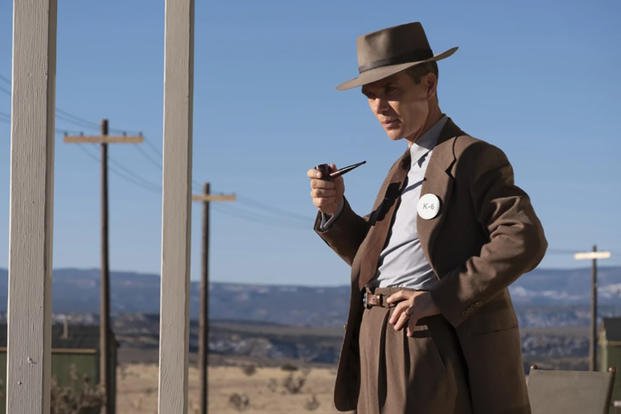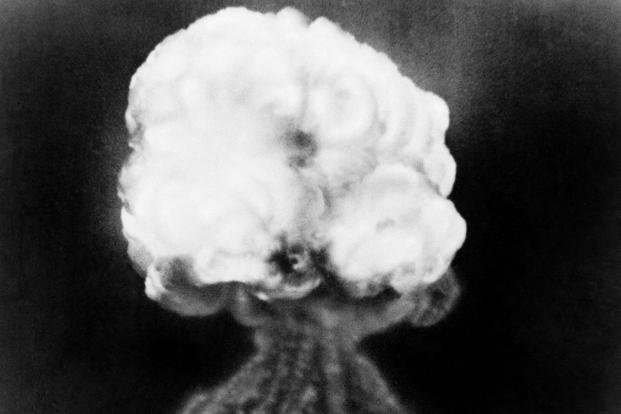When the first atomic weapon exploded with unearthly force in the scrub desert of New Mexico on July 16, 1945, the Army was immediately faced with an unusual problem: How do you keep the biggest man-made explosion ever produced a secret?
To ensure that the test of the new doomsday bomb of unknown strength -- code-named "‘Trinity" -- would remain completely secret from the public, the U.S. government had selected a remote stretch of land more than 200 miles south of Los Alamos for the test, well isolated from prying civilian eyes. But immediately after Trinity detonated with the force of nearly 25,000 tons of TNT just before 5:30 a.m. “Mountain War Time,” frightened and confused Americans began calling police and newspaper offices to report what they thought might be earthquakes or plane crashes.
“The effects could well be called unprecedented, magnificent, beautiful, stupendous and terrifying,” reported Army Brig. Gen. Thomas Farrell, who was in a bunker about 5.7 miles from ground zero with J. Robert Oppenheimer, director of the Manhattan Project’s Los Alamos Laboratory, when the bomb went off. The chief deputy to Manhattan Project director Brig. Gen. Leslie Groves, Farrell would write in a report to President Harry Truman five days later that the immense power unleashed “made us feel we puny things were blasphemous to dare tamper with the forces previously reserved for the Almighty.”
Groves was determined to keep the Trinity test’s top-secret lid in place. To ease the concerns of citizens about the mushroom cloud rising to 50,000 feet, or the shock wave that surged across the Tularosa Basin and broke windows 120 miles away, or the blinding light visible in neighboring states, or the white flakes of fallout that came down as so much radioactive snow, the Alamogordo (New Mexico) Army Air Base put out a not-to-worry press release.
"Several inquiries have been received concerning a heavy explosion which occurred on the Alamogordo Air base reservation this morning,” but it was only an explosion at an ammo dump, the release said. “There was no loss of life or injury to anyone, and the property damage outside of the explosives magazine was negligible.”
But there was injury and there was loss of life, which would become evident over the years in the form of increased rates of cancer and other diseases not only for those downwind of the Trinity blast, but also for the uranium miners who dug the fuel for the ultimate weapons of mass destruction.

Only after the uranium-235 atomic bomb dubbed “Little Boy” destroyed Hiroshima on Aug. 6, 1945, and the plutonium-239 bomb called “Fat Man” leveled Nagasaki three days later, did the U.S. officially admit that what had happened earlier in the New Mexico desert was the result of scientists splitting the atom.
The first use of atomic weapons brought about the surrender of Japan and the end of World War II, but also triggered a nuclear arms race with the Soviet Union in the Cold War years after the war. In the race to develop more powerful weapons, the U.S. conducted more than 100 above-ground tests -- most of them at the Nevada Test Site about 65 miles north of Las Vegas and also in the Pacific until the atmospheric tests were discontinued in 1962.
In the following years, numerous lawsuits were filed in an effort to gain compensation and medical care for those who may have been harmed by the fallout, but appellate courts routinely dismissed the cases. Then in 1990, Congress finally got around to acknowledging the harm done to Americans from exposure to radiation from the nuclear tests by passing the Radiation Exposure Compensation Act.
The Justice Department, which administers RECA, described the act as offering “an apology and monetary compensation to individuals who contracted certain cancers and other serious diseases as a result of their exposure to radiation released during above-ground nuclear weapons tests,” or as a result of exposure in the uranium mines.
Through 2022, the RECA program had paid out $2.6 billion in connection with more than 40,200 approved claims, but the current RECA law limits claims relating to atmospheric testing to parts of Arizona, Nevada and Utah and, remarkably, leaves out New Mexico, where the Atomic Age was born.
The exclusion of New Mexico from RECA was the ultimate injustice in the estimation of Tina Cordova, a thyroid cancer survivor and co-founder of the Tularosa Basin Downwinders Consortium, who has been lobbying, demonstrating and testifying since 2005 to amend RECA to include New Mexico.
“Without the people of New Mexico” to support the work of Oppenheimer and the Army, “there wouldn’t have been a Manhattan Project,” Cordova said in a phone interview. In congressional testimony, she has posed the question: “How many people have to die before the United States pays attention and makes it right?”
Cordova suspects that the exclusion of New Mexico from the RECA program stemmed from the secrecy of the Manhattan Project and long-standing reluctance of the U.S. government to admit that the first victims of an atomic bomb were Americans.
Oppenheimer and the scientists he recruited to develop the bomb at Los Alamos were well aware of the potential for harm to civilians from the Trinity blast, but the blockbuster movie “Oppenheimer,” which won the Academy Award for Best Picture, made no mention of the widespread fallout.
“The whole Oppenheimer thing -- such a huge disappointment,” Cordova said of the lost opportunity in the movie “to at least acknowledge the sacrifice and suffering of the people of New Mexico.”

The world's most renowned scientists and engineers, recruited by Oppenheimer for the crash program to develop atomic weapons, were well aware of the dangers from fallout, but the tight secrecy dictated by Groves always had priority over safety in the Manhattan Project.
“New Mexico residents were neither warned before the 1945 Trinity blast, informed of health hazards afterward, nor evacuated before, during, or after the test," according to a 2010 report by the Centers for Disease Control and Prevention. "Exposure rates in public areas from the world’s first nuclear explosion were measured at levels 10,000 times higher than currently allowed.”
In addition, the Department of Energy (DoE) said the U.S. government knew from the outset that the Trinity test came with the potential for “radiation hazards.” Indeed, soon after the mushroom cloud from the Trinity blast dissipated, physicist Robert Wilson, the head of research at Los Alamos, led an observation team north from the test site. The needles on their Geiger counters were jumping, and the team took note of a reddish-brown cloud of radioactivity drifting north.
Stafford Warren, chief medical officer for the Manhattan Project, reported to Groves that "the dust outfall from the various portions of the cloud was potentially a very dangerous hazard over a band almost 30 miles wide extending almost 90 miles northeast of the site."
But a study by the Program on Science and Global Security at Princeton University, first reported last July by The New York Times, concluded that the fallout from Trinity was far more widespread than initially thought and extended to 46 states, as well as parts of Canada and Mexico.
In response to long-standing New Mexico community concerns, Congress in 2020 requested an investigation by the National Cancer Institute on the possible harmful effects of the Trinity test. In its August 2023 report, NCI noted the difficulty of estimating the number of cancer cases that could be attributed to the long-ago Trinity test fallout but said that the data available suggested that “perhaps several hundred cancers, primarily thyroid cancer, have already occurred,” and “a small number are projected to occur in the future that would not have occurred in the absence of radiation exposure from Trinity fallout.”
For the last 15 years, first in the House of Representatives and now as a senator, Sen. Ben Ray Lujan (D-New Mexico) has been trying to get his state included in RECA and for 15 years has gotten nowhere.
This year, he has sponsored yet another bill to extend by six years the RECA program, which is due to sunset in July, and expand the act’s coverage to include New Mexico and also residents of Alaska, Colorado, Idaho, Kentucky, Missouri, Montana, Tennessee and Guam.
On March 7, the bill passed in the Senate by a vote of 69-30, but once again its fate is uncertain in the House. Last year, a RECA extension and expansion bill also passed the Senate by a lopsided margin as an amendment to the National Defense Authorization Act but was stripped out of the NDAA on the House side.
In a statement to Military.com, Lujan said he has yet to figure out why New Mexico has been excluded from the RECA program. “Nearly eight decades after the Trinity Test in New Mexico, New Mexicans are still left out of the original RECA program,” Lujan said. “I have never been able to get a meaningful answer on why that is, even though New Mexico was ground zero for the atomic bomb. It’s deeply wrong.”
While Lujan’s bill awaits action in the House, the Tularosa Basin Downwinders Consortium points to the affidavits collected from New Mexicans such as Alex Chavez, who experienced the lingering effects of the Trinity blast, to confirm the harm done by the fallout.
“In 1945, I was 10 years old living in Tularosa, New Mexico,” Chavez wrote. “I remember July 16, 1945. I was asleep when the bomb went off -- the whole house shook -- I thought our windows were going to break. My Dad was outside doing his chores as we always had a garden that we ate from and livestock that we raised to eat. I ran outside to see what happened and if my Dad was OK as we were all scared to death.
“I had skin cancer, my mother was diagnosed with breast cancer, my brother Ernest died of lung cancer, two of my daughters were diagnosed with breast cancer – one at the age of 34 and the other at the age of 40,” he wrote. “My other two daughters have had issues with tumors in their breasts as well.
“We always had a cistern -- that was the only water we had. No one ever told us not to drink it. No one ever told us about the bomb. Period.”
















